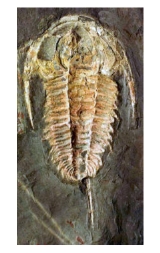
Redlichiina
Encyclopedia
Redlichiina is a suborder of the order Redlichiida
of Trilobite
s. The suborder contains three superfamilies: Emuelloidea, Redlichioidea and Paradoxidoidea. These trilobites are some of the oldest trilobites known. They originated at the beginning of the Cambrian
era and disappeared (possibly by evolving into members of the Ptychopariida
order) at the end of the middle Cambrian.
article for a definition of morphological terms)
Cephalon: Opisthoparian facial sutures. Early forms tend to have tapering, conical glabella with furrows extending far backwards while later forms with glabella expanding forwards to inflated frontal lobe. The hypostome is conterminant (e.g., Redlichia
) or natant (e.g., Dolerolenus). The rostral plate is narrower than in suborder Olenellina
, bound by rostral and connective sutures.
Thorax
: Fulcrate or non-fulcrate, typically with many segments (60+ in an Emmuelid). The axis is infrequently spine-bearing.
Pygidium
: Typically small, but can be larger and with many segments.
Redlichiida
Redlichiida is an order within the major extinct arthropod class Trilobita. The Redlichids are one of the four older classes of trilobites that originated in the Lower Cambrian....
of Trilobite
Trilobite
Trilobites are a well-known fossil group of extinct marine arthropods that form the class Trilobita. The first appearance of trilobites in the fossil record defines the base of the Atdabanian stage of the Early Cambrian period , and they flourished throughout the lower Paleozoic era before...
s. The suborder contains three superfamilies: Emuelloidea, Redlichioidea and Paradoxidoidea. These trilobites are some of the oldest trilobites known. They originated at the beginning of the Cambrian
Cambrian
The Cambrian is the first geological period of the Paleozoic Era, lasting from Mya ; it is succeeded by the Ordovician. Its subdivisions, and indeed its base, are somewhat in flux. The period was established by Adam Sedgwick, who named it after Cambria, the Latin name for Wales, where Britain's...
era and disappeared (possibly by evolving into members of the Ptychopariida
Ptychopariida
Ptychopariida is a large, heterogeneous order of trilobite containing some of the most primitive species known. Many date to the Early Cambrian Period, but the order was extant through the Late Ordovician...
order) at the end of the middle Cambrian.
Physiology
(See the TrilobiteTrilobite
Trilobites are a well-known fossil group of extinct marine arthropods that form the class Trilobita. The first appearance of trilobites in the fossil record defines the base of the Atdabanian stage of the Early Cambrian period , and they flourished throughout the lower Paleozoic era before...
article for a definition of morphological terms)
Cephalon: Opisthoparian facial sutures. Early forms tend to have tapering, conical glabella with furrows extending far backwards while later forms with glabella expanding forwards to inflated frontal lobe. The hypostome is conterminant (e.g., Redlichia
Redlichia
Redlichia is a genus of trilobite of the Redlichiidae family, from the lower Cambrian period. Their fossils are found chiefly in Australia....
) or natant (e.g., Dolerolenus). The rostral plate is narrower than in suborder Olenellina
Olenellina
Olenellina is a suborder of the order Redlichiida of Trilobites. The suborder contains two superfamilies: Olenelloidea , and Fallotaspidoidea . The Olenillina are some of the most primitive trilobites...
, bound by rostral and connective sutures.
Thorax
Thorax
The thorax is a division of an animal's body that lies between the head and the abdomen.-In tetrapods:...
: Fulcrate or non-fulcrate, typically with many segments (60+ in an Emmuelid). The axis is infrequently spine-bearing.
Pygidium
Pygidium
The pygidium is the posterior body part or shield of crustaceans and some other arthropods, such as insects and the extinct trilobites. It contains the anus and, in females, the ovipositor...
: Typically small, but can be larger and with many segments.

